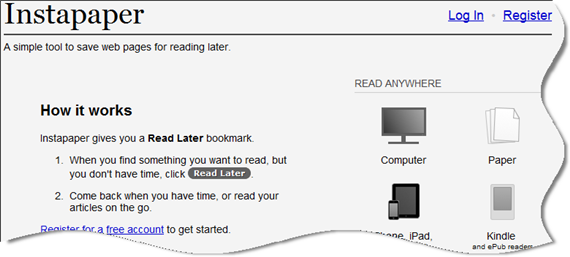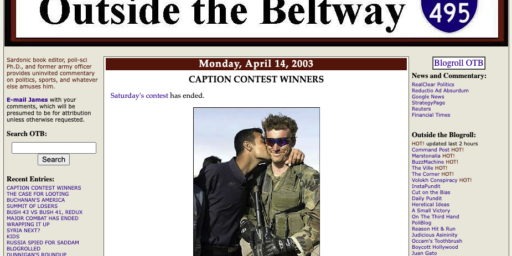Instapaper’s Business Model: Theft?
InstaPaper's business model is stealing content created by others, stripping it of the ads that pay the creators, and running their own advertising on it.
I’m seeing quite a bit of buzz over Instapaper, almost all of it good. But there seems to be a wee problem with its business model.
A couple of years ago, Marco Arment, who was then the lead technologist of the social-blog platform Tumblr, became frustrated with the way the web made his ideal reading diet difficult.
He couldn’t read articles during his commute on the subway because there’s no Wifi in the tunnels. And when he was connected, either on a computer screen or a phone, it was taxing to browse through sites designed with seas of links, come-hither slideshow promotion-boxes and “interactive” advertisements and find the articles he actually wanted to read.
[…]
So he created an application to fix his reading experience. It was a simple bookmarking tool, custom-made for Arment, that allowed him to save articles to read at a time and in a digital environment more conducive to reading. He called it Instapaper.
He could bookmark articles from The New York Times, The New Yorker, the tech blog Gizmodo; load the text form each piece into a simple, custom-made template that stripped away formatting and distractions; and queue the articles into an account so he could read the articles whenever he liked, online or off.
[…]
Instapaper is ad-supported (in the form of small, square ads on users’ account pages and at the bottom of the article pages). Although a basic form of the Iphone application is available for free, Arment gets a cut any time someone downloads the $4.99 version, which is Ipad-friendly and includes more features. This week, he announced his very first, albeit small, scheme for more direct funding: “subscriptions,” for three dollars for three months of service.
So, essentially, InstaPaper’s business model is stealing content created by others, stripping it of the ads that pay the creators, and running their own advertising on it?
The argument, apparently, is that these people already “viewed” the ad when they loaded the article the first time to save a copy to Instapaper. Except that they haven’t: The whole point is to save the piece for later reading.
To be sure, much the same argument has been made against bloggers: Many of us profit from excerpting the work of mainstream media outlets. The difference is that our value added is commentary and/or curation. And we’re generally linking the original — not only driving traffic but increasing search engine ranking for the creating site — and excerpting only part of the content.
Additionally, most professional websites are designed to drive readers of a particular article to others that might interest them. Those reading on an aggregator site obviously aren’t getting that.
A related lament about Instapaper and similar services is aesthetic: They strip the graphic design from the original, leaving only a raw text experience. That doesn’t strike me as a big deal in and of itself, although it might eventually drive down the design quality of sites.






My own experience is that I save an article for later reading only after I am a few paragraphs into it and find it compelling, and realize I don’t have the time now to read the whole thing. By then i have already scrolled past most of the ads – there rarely are adds down near the bottom of long essays (for obvious reasons!).
So, essentially, InstaPaper’s business model is stealing content created by others, stripping it of the ads that pay the creators, and running their own advertising on it?
Like many RSS aggregators do.
Additionally, most professional websites are designed to drive readers of a particular article to others that might interest them. Those reading on an aggregator site obviously aren’t getting that.
As they aren’t by viewing web content via RSS.
James, a website is not a dead tree book, or a DVD, or any other medium in which the creators maintain control over every aspect. It’s all just bits. I can adjust my browser right now to remove all the ads from a website and view it in a trimmed down version. I can just receive the text in an RSS reader. Hell, I can have the text translated to speech and listen to the content if I want.
This is the medium you have chosen. Embrace it. Attempts by content creators to control their content the way they could with other media are foolhardy and sisyphean.
Mantis,
What Instapaper is doing is similar to an RSS reader, but imagine that the ad revenue in the RSS feeds went to Google instead of the content creators, and you see the problem. It’s not JUST that Instapaper is providing a different form for the content, it’s that they’re profiting off of content without compensating the creators of the content. If it were possible to code so that the ads in Instapaper went to creators, like they do in RSS feeds, that would be a different story.
What Instapaper is doing is similar to an RSS reader, but imagine that the ad revenue in the RSS feeds went to Google instead of the content creators, and you see the problem.
Actually, I was talking about RSS readers which insert their own ads, not the ads on the websites they get content from. Now, some have tailored their blogs so that their site displays ads in the RSS feed, either embedded in the post or as separate posts themselves. But guess what, you can get rid of those too if you want.
It’s not JUST that Instapaper is providing a different form for the content, it’s that they’re profiting off of content without compensating the creators of the content.
You mean kind of like this website? Oh, right, you have links so it’s ok for you to do it.
If it were possible to code so that the ads in Instapaper went to creators, like they do in RSS feeds, that would be a different story.
How about OTB sends its ad revenue to the sites from which the authors retrieve content on a daily basis? You know, mostly news companies that are having trouble staying in business…
This is directly addressed in the piece. We provide traffic and pagerank to the originating site and use just enough of the original — clearly delineated as such — to set up the commentary. Indeed, we have mainstream media flacks constantly sending us emails asking us to link and use their stories!
We provide traffic and pagerank to the originating site and use just enough of the original — clearly delineated as such — to set up the commentary. Indeed, we have mainstream media flacks constantly sending us emails asking us to link and use their stories!
You display advertisements and make money by reproducing others content, which you link to, and commenting on it. There is no guarantee that readers will click those links and visit the original content owner. Instapaper saves websites that the user has already visited.
You complain that Instapaper’s users haven’t clicked the ads on the content pages they are saving, because they are saving them for later, but you don’t know that. People bookmark web pages for many different reasons, not just because they haven’t looked at them and want to do so later. In any case, your claim is extremely weak in comparison because while Instapaper’s users have definitely visited the sites they save, many of your readers will never click the links to content you use. How you can possibly think your model is better for the content producer, or that your ad revenue is somehow morally superior to that of Instapaper, is beyond me.
Because my co-bloggers and I are content producers. People are coming to read the content we produce, not the snippets from NYT or whatever. We provide those for context but could easily do the journalisty thing and paraphrase the original. Linking and blockquoting, though, gives more credit to the originators of the breaking news and sends some traffic back.
Because my co-bloggers and I are content producers.
Yes, but that doesn’t mean your blog is morally superior to Instapaper. You provide added value to the content you use by providing analysis and comment. Instapaper provides added value by enabling users to take it with them when they go to places without an internet connection. It’s not as if we’re talking about a normal website which simply reproduces the New York Times with its own ads. We’re talking about software that allows consumers to do something they couldn’t do before.
Wait – ads are produced in RSS feeds? I’ve never seen any ads in my Google Feed. Does Google just give you guys money for every subscriber, or something?
A goodly number of the sites I subscribe to have ads. Some even have standalone posts that are nothing but an ad. Payouts are very, very low and on a per impression basis.
>So, essentially, InstaPaper’s business model is stealing content created by others, stripping it of the ads that pay the creators, and running their own advertising on it?
Why not, that’s google’s business model and it’s worked for them.